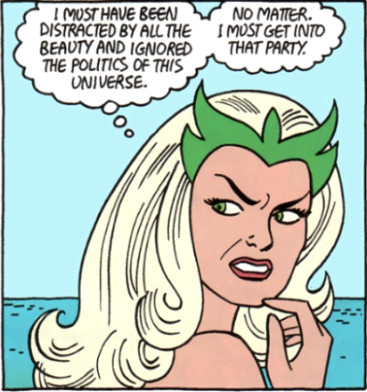
“When deeds speak, words are nothing.”In the corners of the sports world where volume outweighs substance, there was a debate over whether or not the US Women’s Soccer Team “choked” by losing to Japan. I’m not interested in the merits of the case; I have always thought labels like “choker” belong to the sort of glib moralizing that pretends to know what’s in an athlete’s head and heart while projecting the author’s pat opinions onto them.1 Despite the vapidity of the debate, though, I was happy to see it. It means we’ve come to a place where discussions of women’s soccer are about the nature of the play, not merely the fact that it exists.
— Pierre-Joseph Proudhon
1: I have not yet run into a single article of this kind that manages to marry its moralizing to meaningful analysis of the actual play of the match, or really of any kind. I suppose such writing is possible, in the same way that a manned mission to Mars is possible, but I'm not holding my breath.High-level women’s team sports is a relatively recent phenomenon. Women have competed in tennis for decades and in the Olympics starting in 19002, but professional women’s sports leagues didn’t really become a viable enterprise until the 1990s.3 The calculus here seems pretty simple: Title IX flung open the gates to team sports for young women starting in 1972. By the 90s, the infrastructure had been in place long enough for there to be a generation of women who had grown up playing soccer and basketball under more or less competent coaches, the best of which women were good enough to go pro and the rest of whom were at least potentially interested in following them. Leagues for those sports have existed more or less since, though never as raging financial successes. The WNBA is operated by the NBA, reportedly at a loss, and women’s soccer has seen one league fold and WPS is currently fairly marginal.
2: Women competed in track and field starting in 1928, but some many of the competitors collapsed at the end of the first 800m run that it was not run again until 1960. That probably speaks most to interwar-era female athletic training regimes, but it also says a lot about those runners. Way to go hard, ladies!
3: I am, of course, dealing here with American athletes and markets because that’s what I know at least a little. The story obviously varies depending on where you look, but for Western sports things seem to hew pretty closely to the timeline of a spike in interest concurrent with women’s suffrage movements early in the 20th century which was then stamped out by male-run organizations, and things lying largely dormant until some point after the 1970s and before 2000.Is that really surprising, though? The big three sports are multimedia juggernauts because they had a century of build-up, not to mention the luxury of not having to overcome prejudices about what athletes should look like. They make millions upon millions these days because they command large television audiences and the advertising dollars that stalk those demographics. Anyone expecting female pro sports to simply vault into prominence is fooling him- or herself. No sports league has jumped from non-existence to sustained juggernaut. There have been a few flashes in the pan, but even those were direct competitors to existing leagues. But dismissing the WNBA and WPS as irrelevant ignores the mechanics of fandom. We root for the sports we understand, that have become ingrained in how we think about sport in general.

Play is a universal human impulse. Some of us feel it more strongly than others, but everyone is wired to play, and therefore on some level also for sport. Male dominance of the field has nothing to do with it being a uniquely male impulse and everything to do with the historical interplay of physiological dominance and sexism. We think of athletes as male by default because athletes have always been presented to us as male. That’s why it’s the called the Women’s World Cup. Arguments that the WNBA and WPS are doomed to failure, either because they're economically inviable or a pale imitation of “true” (i.e. men’s) versions of the same sport, pretend that the sports universe is static.
Very few of us care passionately about sports that we didn’t play or follow as children. I am a baseball fan because the Cincinnati Reds won the World Series when I was seven, and I wanted to be an infielder because I wore glasses and so did Chris Sabo4. Were I female, the first such role model I could have had would have been a member of the 1991 Women’s World Cup-winning national team, with the first regular pro teams appearing for me later that decade. I’m sure plenty of women have grown up with male athlete role models, but there’s a world of difference between wanting to play a game like someone and wanting to grow up to be your own version of them.
4: Were I cooler, I would have wanted to be Eric Davis or Barry Larkin. But this was a year or two before I supported Ross Perot's bid for president because we both had big ears. Cool was not on my radar when I was seven.

Joe Posnanski wrote a piece that was about, among other things, watching the WWC final with his two daughters. He focused on their different reactions to the US team’s loss, but I was struck by the fact that those girls will be growing up in a world where women have always had the option to be professional soccer or basketball players. The most powerful things are those that everyone takes for granted. The viability of the WNBA and WPS is debatable because they’re still new and we can easily imagine them not existing. Those arguing against aren’t interested in what they’re selling, and, whether for reasons of misogyny or other bias, would prefer they go away. Those arguing for are the already converted.5 But twenty years from now, I would be shocked if there weren’t two or three relatively profitable women’s professional sports leagues. Women, you may have heard, make up roughly half of the populace, and despite all the messages in sports and culture telling them to go away and not pay attention, have long cared about sports. Right now it is in some ways remarkable that these leagues exist, but when they have been around for a generation, it will be normal, and that’s how they will get big numbers. Unless women disappear or television and the internet vanish, I can’t help but think their growth will be as inevitable as it will be slow. We’ll all be the better for it, because everyone deserves role models who look like them. Besides, how can more and more varied sports be a bad thing?
5: I of course think that those arguing for the leagues are wholly right. But the point is that there is no debate. That's more or less impossible when one side is a casually misogynistic polemic and the other side is marginalized by the size of its platform.

No comments:
Post a Comment